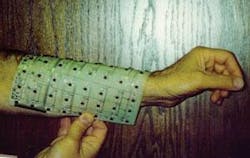PROXIMITY SENSING: NASA is drawn to IR-based sensitive skin

Some of the technologies being harnessed by NASA for the proposed colonization of the Moon and Mars offer significant potential for creating a “new world” right here. For example, flexible IR sensing arrays developed by Vladimir Lumelsky at the University of Wisconsin-Madison have now become a research focus at the NASA Goddard Space Flight Center (Greenbelt, MD). Infrared technology is just one of several contact- and proximity-sensing methods that Lumelsky hopes to combine to endow robots with “sensitive skin,” enabling them to operate safely in unstructured environments.
Humans and animals rely more fundamentally on sensing through the skin than on vision in navigating our highly unstructured world, Lumelsky explains. People can learn to live and get around without vision, but once people lose their skin sensing, as can happen in extremities, for instance, in diseases such as diabetes and hepatitis, the affected body part must be carefully guarded to prevent damage. Similarly, a robot, even with a very sophisticated vision system, must operate in a controlled or structured environment to keep from damaging itself or its environment. As an example, Lumelsky points out that the automotive industry pays on the order of $70,000 for a robotic arm to weld joints or apply paint, and then pays another $200,000 to $300,000 for a specially designed work cell in which to house it.1
Lumelsky’s proposed solution is to imbue such a robotic arm, for instance, with skin sensing, so, like a human or animal arm, it would be capable of “feeling” unexpected obstructions and impediments in an unstructured environment and responding appropriately. He points out, though, that robotic touch, unlike human touch, may not always be tactile. Relatively soft and flexible human skin acts like a buffer, so unexpected contact with an object is not normally destructive, as might be the case with a motorized metallic robot arm. Lumelsky envisions including piezoelectric or other force-sensing elements in robot skin to sense actual contact with objects if needed, but he is currently focusing on proximity-sensing elements, among which IR light-emitting-diode (LED) emitters and sensors are currently foremost.
Compared with other possible proximity-sensing technologies, such as ultrasound and capacitive methods, LEDs offer better spatial resolution, which enables the robot to move more quickly and surely. And replacing LED illumination with lasers could further improve resolution. So far, Lumelsky and colleagues have used 1200 to 1300 sensing elements to sensitize a human-size robot arm in a university laboratory. The elements were placed in modules consisting of 8 × 8 arrays of IR-sensor pairs (LEDs and detectors), with some data processing prior to passing data on for more-global processing functions, such as controlling the motors that actually move the robot arm (see figure).
Sensing finely
While a thousand or so sensing elements may work for a robot arm in a laboratory environment, Lumelsky points out that sensitivity for real-world applications (potentially ranging from assisting handicapped or elderly people who live alone, to performing street maintenance or military duties) might require millions of sensors over a similar surface area depending on the proposed application. While the basic technology exists to create sensitive robot skin, numerous engineering challenges remain, from further developing the sensors themselves through the data processing steps and actual motor control. But the possibilities are likely to be worth it, according to Lumelsky.
Endowing machines with an ability to sense their surroundings would enable unsupervised machinery to operate “cautiously” in unstructured, unpredictable surroundings and to be “friendly” to the working environment. The approach could be useful in service industries and could make important contributions to human prosthetics, as well as augmenting human sensing when fashioned into clothing. In addition, the capability to generate and process data flows in real time on a massive scale could further accelerate the information revolution. “Sensitive skin presents a new paradigm in sensing and control,” he notes. “It is an enabling technology with far-reaching applications, from medicine and biology to industry and defense.”2
At NASA, Lumelsky’s sensitive skin is one of several projects intended to enable robot-assisted space exploration. Other projects include development of robots with reasoning and speech capabilities for working cooperatively with humans, and development of shape-shifting aggregations of miniature robots currently referred to as autonomous nanotechnology swarms (ANTs). Even if such technologies never leave the ground, they will still likely bring about major changes to life on Earth.
REFERENCES
1. S. O’Keefe, The Vision for Space Exploration, NASA (February 2004).
2. V. J. Lumelsky et al., IEEE Sensors J. 1(1) 41 (June 2001).
About the Author
Hassaun A. Jones-Bey
Senior Editor and Freelance Writer
Hassaun A. Jones-Bey was a senior editor and then freelance writer for Laser Focus World.